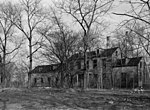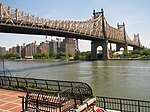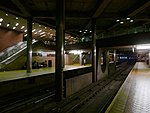Roosevelt Island is an island in New York City's East River, within the borough of Manhattan. It lies between Manhattan Island to the west, and the borough of Queens, on Long Island, to the east. Running from the equivalent of East 46th to 85th Streets on Manhattan Island, it is about 2 miles (3.2 km) long, with a maximum width of 800 feet (240 m), and a total area of 147 acres (0.59 km2). Together with Mill Rock, Roosevelt Island constitutes Manhattan's Census Tract 238, which has a land area of 0.279 sq mi (0.72 km2), and had a population of 11,722 as of the 2020 United States Census.Lying below the Queensboro Bridge, the island cannot be accessed directly from the bridge itself. Vehicular traffic uses the Roosevelt Island Bridge to access the island from Astoria, Queens, though the island is not designed for vehicular traffic and has several areas designed as car-free zones. Several public transportation options to reach the island exist. The Roosevelt Island Tramway, the oldest urban commuter tramway in the U.S, connects the island to Manhattan Island's Upper East Side. The Roosevelt Island station carries the F and trains of the New York City Subway. The NYC Ferry also maintains a dock on the east side of the island. On-island transport is provided by the Red Bus service.
The island was called Minnehanonck by the Lenape and Varkens Eylandt (Hog Island) by the Dutch during the colonial era and later Blackwell's Island. It was known as Welfare Island when it was used principally for hospitals, from 1921 to 1973. It was renamed Roosevelt Island (in honor of Franklin D. Roosevelt) in 1973.Roosevelt Island is owned by the city but was leased to the New York State Urban Development Corporation for 99 years in 1969. Most of the residential buildings on Roosevelt Island are rental buildings. There is also a cooperative named Rivercross and a condominium building named Riverwalk. One rental building (Eastwood) has left New York State's Mitchell-Lama Housing Program, though current residents are still protected. It is now called Roosevelt Landings. There are attempts to privatize three other buildings, including the cooperative. The New York City Fire Department also maintains its Special Operations Command facility at 750 Main St. on the island.










